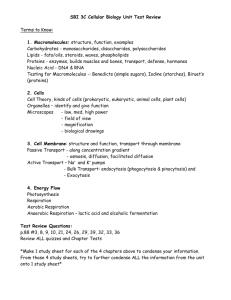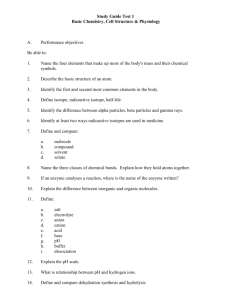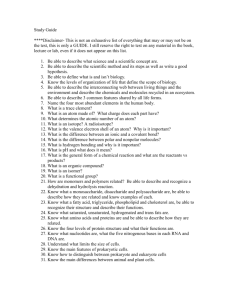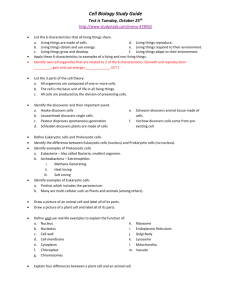Ecology Vocabulary Words
advertisement
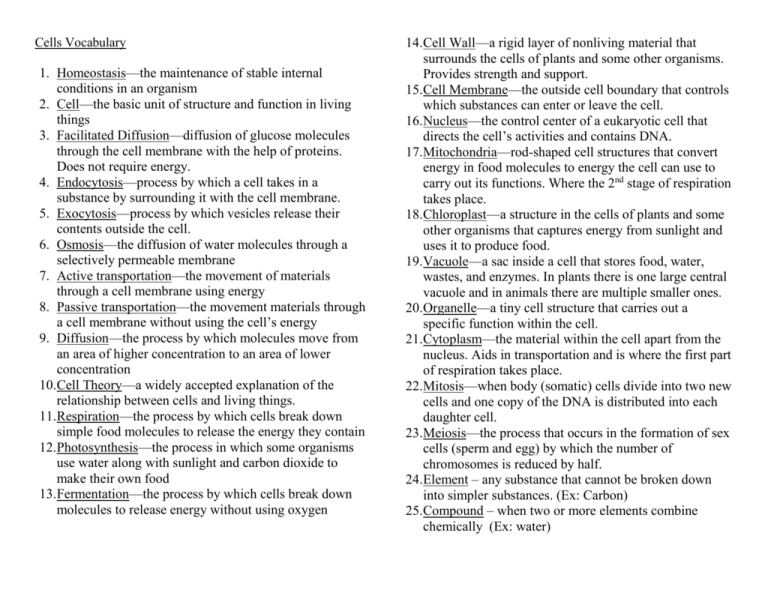
Cells Vocabulary 1. Homeostasis—the maintenance of stable internal conditions in an organism 2. Cell—the basic unit of structure and function in living things 3. Facilitated Diffusion—diffusion of glucose molecules through the cell membrane with the help of proteins. Does not require energy. 4. Endocytosis—process by which a cell takes in a substance by surrounding it with the cell membrane. 5. Exocytosis—process by which vesicles release their contents outside the cell. 6. Osmosis—the diffusion of water molecules through a selectively permeable membrane 7. Active transportation—the movement of materials through a cell membrane using energy 8. Passive transportation—the movement materials through a cell membrane without using the cell’s energy 9. Diffusion—the process by which molecules move from an area of higher concentration to an area of lower concentration 10.Cell Theory—a widely accepted explanation of the relationship between cells and living things. 11.Respiration—the process by which cells break down simple food molecules to release the energy they contain 12.Photosynthesis—the process in which some organisms use water along with sunlight and carbon dioxide to make their own food 13.Fermentation—the process by which cells break down molecules to release energy without using oxygen 14.Cell Wall—a rigid layer of nonliving material that surrounds the cells of plants and some other organisms. Provides strength and support. 15.Cell Membrane—the outside cell boundary that controls which substances can enter or leave the cell. 16.Nucleus—the control center of a eukaryotic cell that directs the cell’s activities and contains DNA. 17.Mitochondria—rod-shaped cell structures that convert energy in food molecules to energy the cell can use to carry out its functions. Where the 2nd stage of respiration takes place. 18.Chloroplast—a structure in the cells of plants and some other organisms that captures energy from sunlight and uses it to produce food. 19.Vacuole—a sac inside a cell that stores food, water, wastes, and enzymes. In plants there is one large central vacuole and in animals there are multiple smaller ones. 20.Organelle—a tiny cell structure that carries out a specific function within the cell. 21.Cytoplasm—the material within the cell apart from the nucleus. Aids in transportation and is where the first part of respiration takes place. 22.Mitosis—when body (somatic) cells divide into two new cells and one copy of the DNA is distributed into each daughter cell. 23.Meiosis—the process that occurs in the formation of sex cells (sperm and egg) by which the number of chromosomes is reduced by half. 24.Element – any substance that cannot be broken down into simpler substances. (Ex: Carbon) 25.Compound – when two or more elements combine chemically (Ex: water) Name: _______________________________________ Vocabulary Choice Board Due Friday October 23rd. You will choose 3 options; one of which must be the middle. *You cannot use the same words for your 2nd and 3rd choices. Create a “meme” for ten words that helps explain what the word means. Be sure to include the term with each. Cut pictures or words from magazines or newspapers that represent the meaning of at least 10 vocabulary words. Write terms next to their depictions. For at least 10 vocabulary words, list 8 words that can be associated with that word. *Tip: Create a “word cloud” using Wordle Required Vocabulary Activity Comic Strip You can draw one comic strip that uses at least 5 of the words or create a separate strip for each word. Create Flash Cards for all vocabulary. Make a booklet of at least 10 words and their meaning using your own drawing. (www.makebeliefscomix.com) This can be handwritten on index cards or using Quizlet. Make an acrostic for at least 5 of your vocabulary words. The words you choose for each letter should be related to the word written downward. Using at least 15 of your vocabulary words, create a crossword puzzle. Be creative in the clues that you use. Do not always use the definition for that clue. Use at least 10 of your vocabulary words in an original story. Be sure to underline each word for your audience.




